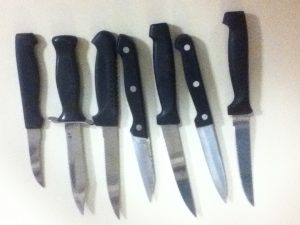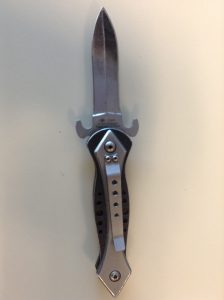Options for Police Officers During A Traffic Stop
© Copyright 2017 Dan Donzella & Tim Boehlert
In March I had the good fortune of networking with a gentleman on Facebook that seemed to agree with some of my postings – and he had some very good insights to add. I’m always reluctant to reach out and ask too many questions for fear of pushing people away, because in my business, it’s always hard to find like-minded professionals. And while it’s great therapy for me to exorcise some deep-seated thinking, it’s often disturbing to others not acclimated to what I did for years.
I’d like to introduce you to Dan Donzella. Dan is a Martial Artist, an Instructor/Consultant for Police Departments and also a Firearms Instructor. I had asked Dan outright if we could have a phone conversation – I was very curious about his thoughts and experience, and wanted to develop a conversation off-line. We spent over an hour poking around some dark corners, and I finally had to pop some disturbing questions on him! Lo and behold, not only did he agree, but also HELL YEAH! He agreed with my viewpoints.
Understand one thing about some of our civil servants. They are not always forthcoming with talking about, let alone sharing information that is of a specific nature. They generally don’t talk about the job with outsiders, in my opinion of course. I’ve found that many are reluctant to get into specifics or to talk about issues. I’ve also found that training is never discussed.
During my many years of security employment I’ve sought to learn from others – and who better to teach a newbie than a certified Police Officer? I also seek to give back – teach them things that we’d do, based solely on our own abilities or our guidelines. Knowledge is useless if it’s not shared.
In a nutshell, it was great to finally get to the one thing that always bothers me – training. Can we talk about some of it? What are your thoughts about what is taught? Did you see stuff that bothered you? Can we do better? What would you do if you could?
While we have a lot to explore, Dan was kind enough to accept a challenge from me to write his very first article. Dan is a teacher, but not a writer, and we both have that in common, and although he has more ability in many areas than I, we both want to teach better. Dan sent me a few lines of an idea, and I had to wring the rest out. I added my stuff, and took a co-writer option to encourage and guide him through the process, and my expectation is that the next article will be his entirely – and even if I have to edit it, we will strive for autonomy!
What follows is the ‘interview’ process that we undertook after that first phone call where I’d planted the seed to encourage him to share some of his expertise.
TB: Dan, I don’t know much about your background, but you seem to have ties to LE in our community, and we seem to have some very exclusive friends in the MA arena as well as some common friends in the Police community. I also know that you spent some time with a local PD, and did some DT training with their officers. Can you expand on that a bit?
DD: In 2007 a proposal was made to create a Regional Police Academy for numerous police departments. The purpose of this Academy would be to provide standardized training to new recruits while eliminating overlapping policies and tactics and providing a much-better prepared Police force that would be more well equipped to work together with other agencies.
The Department knew me because I had previously taught some of the high-ranking officers. The head of this project felt that the weapons retention course was out of date. He felt that it was inadequate because it was driven by a defensive mindset – strictly addressing problems from a defensive stance. I put together an offensive minded course that was so well received by the movers and shakers that I was then given the task of assessing the Defensive Tactics program and to try and put together a more-modernized version for new recruits as well as seasoned officers.
In doing so, I started by assessing the weapons retention training. Because I am a firearms instructor, and had spent some time on the streets with many of the officers, I was able to find several things that I felt ‘we can do better.’ After being exposed to some of the current training, I knew that I’d have a lot of work to do.
—
TB: I can’t imagine what it would be like to have the responsibility of designing any program for Police Officers – where do you start, what do you prioritize, and how do you cram it all into such a short program, yet provide them with a responsible end-product?
DD: As you may have guessed, it’s nearly impossible to cover all aspects of police work in a school setting. Your FTO (Field Training Officer) and years of experience are crucial parts of a larger puzzle that isn’t the same for any two recruits.
After completing my new Weapons Retention curriculum I began working with the various units within the Police Department. Each job is different though. For instance Traffic Division vs. Street Patrol. I had the unique opportunity to work Traffic Division with the Captain of that division for 2 years. I was getting a lot of questions from officers on “what if’s”, and the most common question I got was about how to extract a person out of their car. What they were asking me was “is there a ‘best’ way to remove the person and not have it end up escalating into a all-out brawl?” What gets taught universally in academies is that officer safety should ALWAYS be their first priority.
—
TB: Can you share any of the issues that you discovered in the field?
DD: The major mistake that I witnessed in the field was that the officers would reach in over the driver with their entire body and with both hands to unfasten the driver’s seat belt. This simple and too common method/error would expose the officer’s firearm, leaving the officer vulnerable to possible attack.
—
TB: You see a lot from a different perspective once you know more – based on years on the street, and/or in other training that you’ve pursued. So, based on this ‘mistake’, how did you address it?
DD: What I came up with were the following changes for those stops where the officer was dealing with a non-cooperative, non-compliant and possibly combative citizen:
[1] The officer should first place his/her right knee against the driver’s hip. This limits the driver’s ability to move offensively against the officer, and also allows the officer to ‘feel’ any sudden movements, but still allows a reasonable degree of control.
[2] Next, the officer places his/her your right forearm across the driver’s jaw-line turning their head away and towards the passenger side of the vehicle. You may ask why the forearm across the jaw? This is a control situation where the officer may need to assist the driver to unbuckle their seatbelt. The driver may be non-compliant for any number of reasons – medical emergency, or perhaps just being plain uncooperative. Reaching across the body without controlling the head in this manner could give the driver a means of pulling the officer into a chokehold. The forearm might actually not even touch the driver but still creates a safer entry technique. Prior and on-going assessment of the situation is always critical. The driver might fake a medical condition to gain surprise or advantage allowing them to get the upper hand on the officer, so always be on your guard.
[3] If needed, i.e. with a combative suspect, apply directed pressure against the driver’s head and into the headrest, rearward momentum. Unbuckle their seat belt with your left hand. Most drivers will exit on their own once they realize that the officer has experience with this behavior and advantage. There’s an old saying in the fighting arts, “Where the head goes, the body will follow.” By using this pain compliance technique, whether the suspect is feeling pain or not, the positioning of their head in this manner and using the suspect’s weight against them bypasses having to deal with their combativeness or resisting limbs to an extent, and is much safer for the officer. It’s called pain compliance for a reason, and it is a legal demonstration of the use of less-than-deadly force.
[4] Instead of fighting with the suspect while citizens are filming you, reach around and behind his head, insert your finger into his carotid artery (the brachial plexus region of the exposed neck) or up under the jaw into his glands with your right hand, the mandibular process. Pull his head up and back, out of the door and down towards the rocker panel. Be patient, as your fingers will penetrate more if the driver resists, making it even more effective and the driver will eventually lose his grip on anything in the car, including the steering wheel and fall out of the vehicle, where he can be cuffed and searched.
[5] It is actually possible to cuff them hanging out of the vehicle. It is a painful technique but with no lasting injuries. The exact same entry using the knee and forearm can be used in any situation entering the suspect’s vehicle. Use it in a much more forceful way if the driver is reaching for a weapon. By smashing him with your knee, elbow and forearm on your way to the hand reaching for the weapon.
So, while some drivers will grab onto the steering wheel, and some have even locked their feet behind the brake pedal, this technique may provide a best-defense entry and extraction strategy, safe for all, because some officers would hit their arms or try to peel their fingers off of the steering wheel, and some would be bitten as a result.
—
TB: I’ve heard the saying that goes something like this “the threat determines the outcome” and I always took that to mean, that they choose to fight or not, to cooperate or not, and when it’s over – you simply oblige them – and I’m not saying this is true nor the reality for you, but in my world it was often very true.
DD: I firmly believe compliance of a suspect relies solely on the experience of the officer. Use of a baton correctly can be useful also, but too many times the public sees that as just an unjustified beating. That can be very bad for a department’s reputation. Use of levers and knowing how the body works is the future of training. Other countries are already way ahead of the U.S. in this process because of their lack of firearms.
—
TB: I have not heard anyone say that before – and in those specific terms to be exact. It’s taken me more than a few years to understand the levers/body equation and how that knowledge can be more useful to us. It took me about two years to come to terms with that and reset my compass to that path – learning more about body mechanics and math vs. muscle and strength. Sometimes it still looks bad though, even when it’s not. How do you address ‘how it looks’ issues?
DD: I have patterned the majority of the arresting techniques that I teach in a way so that they look as non-aggressive as is possible if being filmed. Every department has to deal with the advent of this trend to capture everything the Police do while performing their duties. It does matter how it looks as much as how effective it is, which should always be the officer’s priority.
—
TB: Times have certainly changed. Respect for the law is a thing of the past, sadly. And the media has all but gutted the Police Officer’s ability to get home safe every day. Because of their lack of understanding, one-sided and under-researched articles, and outright deceptive reporting practices, our officers are in more danger every day. The media has painted them as thugs, and with the thought that all they want to do is to use force irresponsibly. That has impacted how the public responds and acts when coming into contact with officers.
DD: An officer stops cars all day long, never knowing what to expect. Sadly, there are too many road rage confrontations, and while some citizens solve it by displaying verbal outbursts only, others end up using deadly force.
Every officer wants a safe traffic stop where the driver of the stopped vehicle stays in their vehicle, the officer does his job, whether it be issuing a warning or writing a citation and then to have them both get back on their separate ways. Unfortunately, today a pleasant, non-combative stop can turn into a shoot-out. It happened just today, again, to a new officer, who was killed by the driver after a ‘routine’ traffic stop. No stop is ever routine, and the word ‘routine’ should be banned from every Police officer’s mind.
—
TB: Anything else that you’d like to share Dan?
DD: We all have seen videos of bar fights and how some bouncers handle the situation. Inexperienced ones get in the brawl and throw punches and toss patrons around. For a club that’s a bad ‘solution’ which can ultimately result in lawsuits, losing their liquor license or losing the business due to adverse reactions from their patrons. An experienced bouncer wants to defuse the mayhem. He can handle the patron with total control using different controlling techniques while adapting to his resistance and without causing harm, which is a sheer pleasure to watch!
In conclusion, constant training and improving not only your skills but also knowledge in your chosen field is a must. You must upgrade yourself, training facilities can last only so long and they must be upgraded as well. Having teachers who ‘think out of the box’ are crucial in this endeavor.
—
TB: I’d like to thank Dan for taking up the challenge and for sharing some unique insights about his training ideology. It’s good to know that there are teachers like him out there that our Police Officers can utilize. And depend on. Dan and I have both seen the effects of incomplete training and we’ve both sought to change that status quo in our own ways. As teachers, we both agree that more can be done, however. We need to get beyond the false sense of security that ‘we’ve learned all that we need.’ That simply is not true.
© Copyright 2017 Dan Donzella & Tim Boehlert






